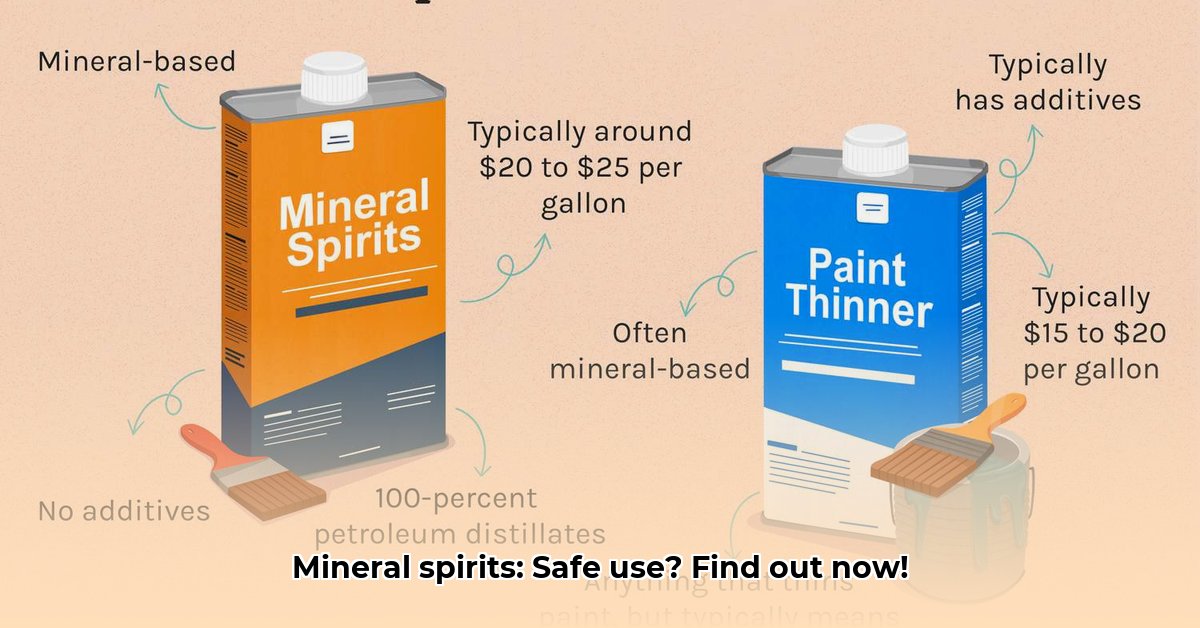Picking the right solvent for your project can be tough with so many choices available. Are you struggling with stubborn paint splatters, or just starting a DIY project and want to do it right? This guide explains mineral spirits – what they are, how they differ from other cleaners, and how to use them safely. We’ll compare them to alternatives like turpentine and acetone, show you how to clean brushes and remove stains, and discuss safer options. Whether you’re a professional or a weekend DIYer, we’ll help you choose and use the best solvent for the job.
Understanding Mineral Spirits: Uses, Composition, and Safety
Let’s explore mineral spirits – a versatile solvent often found in the workshops of DIY enthusiasts and professional painters. Often mistaken as just “paint thinner,” mineral spirits are, in fact, a more refined version. While regular paint thinner can be considered a general-purpose mix, mineral spirits undergo a more careful refinement process. This process reduces the harsh smell, lowers the amount of volatile organic compounds (VOCs), and enhances its cleaning properties, making it a preferred choice for many applications. Mineral spirits typically cost around $15-$30 per gallon, depending on the brand, retailer, and purity.
Composition and Functionality Explained
Chemically, mineral spirits consist of a blend of aliphatic hydrocarbons, primarily carbon and hydrogen atoms linked together in chains. These lightweight molecules make mineral spirits liquid at room temperature and effective at dissolving oils, greases, waxes, and some paints. The refining process eliminates many of the more irritating and potentially harmful aromatic hydrocarbons found in other paint thinners and solvents, resulting in a gentler, more user-friendly product. What percentage of mineral spirits is composed of pure hydrocarbons? Typically, it’s around 95-99% by volume, according to most chemical composition reports, although the exact composition can vary slightly depending on the specific manufacturing process and grade.
Mineral spirits are useful for thinning oil-based paints and varnishes, cleaning paint brushes and equipment, degreasing metal parts, and removing stubborn stains and residues from various surfaces. The relatively mild odor compared to other solvents makes them more suitable for indoor use, provided adequate ventilation is maintained.
Mineral Spirits vs. Other Paint Thinners and Solvents: A Detailed Comparison
Let’s compare mineral spirits to other common paint thinners and solvents, noting that specific properties can vary between brands and formulations. Here’s a general comparison outlining key characteristics:
| Solvent Type | Odor | VOCs | Flashpoint | Toxicity | Evaporation Rate | Typical Cost | Primary Uses |
|---|---|---|---|---|---|---|---|
| Mineral Spirits | Low | Low | 104-140°F | Moderate | Medium | Moderate | Thinning oil-based paints, cleaning brushes, degreasing |
| Turpentine | Strong | Moderate | 95°F | Moderate to High | Fast | Low | Thinning oil-based paints (historical), some artists’ techniques |
| Acetone | Strong | High | 0°F | High | Very Fast | Low | Removing dried paint, dissolving resins |
| Lacquer Thinner | Strong | High | varies | High | Very Fast | Low | Thinning lacquers and similar finishes |
| Water-based Thinners | Low | Very Low | N/A | Low | Slow | Moderate | Thinning water-based paints, cleaning |
| Citrus-based Solvents | Citrus | Low | 120°F+ | Low | Medium | Moderate to High | Cleaning, degreasing, removing adhesives |
Note: Flashpoint indicates the temperature at which a solvent’s vapors can ignite in air; lower flashpoints indicate higher flammability.
As the table shows, mineral spirits offer a reasonable balance of effectiveness, safety, and cost for many common applications. However, the best choice always depends on the specific task, the materials involved, and the user’s personal preferences and safety considerations.
How to Use Mineral Spirits: A Comprehensive Guide
Mineral spirits have a wide range of uses around the home and workshop. Here’s how to use them safely and effectively for some common tasks:
1. Thinning Oil-Based Paints:
- Step 1: Start by adding mineral spirits gradually to your oil-based paint, stirring thoroughly until you reach the desired consistency. A good starting point is a ratio of 1 part mineral spirits to 3 or 4 parts paint, but adjust as needed based on the specific paint and application.
- Step 2: Test the thinned paint on a scrap piece of the material you’ll be painting to ensure the consistency, color, and coverage are correct before applying it to your main project.
- Step 3: Remember that thinning paint will affect its opacity and drying time, so adjust your technique accordingly.
2. Cleaning Paintbrushes:
- Step 1: Remove as much excess paint as possible from the brush by wiping it on newspaper or a clean rag. The less paint you have to dissolve, the longer your mineral spirits will last.
- Step 2: Pour a small amount of mineral spirits into a container and soak the bristles of the oil-based paintbrushes in it, ensuring that the ferrule (the metal part holding the bristles) is also submerged.
- Step 3: Agitate the brush gently to work the solvent through the bristles, loosening the paint. You can also use a brush comb or wire brush specifically designed for cleaning paintbrushes to help remove stubborn paint particles.
- Step 4: Rinse the brush with fresh mineral spirits until the solvent runs clear, indicating that all the paint has been removed.
- Step 5: Shape the bristles back to their original form and allow the brush to air dry completely before storing it.
3. Removing Paint Stains:
- Step 1: Before attempting to remove a paint stain, test mineral spirits on an inconspicuous area of the stained material first to check for any adverse reactions, such as discoloration or damage.
- Step 2: Apply mineral spirits to the paint stain using a clean, white cloth or cotton ball. Avoid using colored cloths, as the dye could transfer to the stained surface.
- Step 3: Gently rub the stain, working from the outside in to prevent spreading it.
- Step 4: Use a clean section of the cloth or a fresh cotton ball frequently to avoid re-depositing the dissolved paint back onto the surface.
- Step 5: Repeat the process as necessary until the stain is completely removed.
- Step 6: Once the stain is gone, clean the area with soap and water to remove any residual mineral spirits.
Essential Safety Measures for Working with Mineral Spirits
Mineral spirits are flammable and can pose health risks if not handled properly, so it’s crucial to take the following safety precautions:
- Ventilation: Always work in a well-ventilated area, preferably outdoors or with open windows and fans to circulate fresh air. If adequate ventilation is not possible, use a respirator equipped with an organic vapor cartridge.
- Protective Gear: Wear chemical-resistant gloves (such as nitrile or neoprene) and eye protection (such as safety goggles) to prevent skin and eye contact.
- Safe Storage: Store mineral spirits in a tightly sealed, original container in a cool, dry place away from heat, sparks, open flames, and direct sunlight. Keep out of reach of children and pets.
- Responsible Disposal: Dispose of used mineral spirits, rags soaked with mineral spirits, and empty containers properly, following local hazardous waste regulations. Never pour mineral spirits down the drain or into the environment. Allow rags soaked in mineral spirits to air dry completely outdoors before discarding them to prevent spontaneous combustion.
Choosing the Right Solvent for Your Specific Needs
Choosing the correct solvent depends on several factors, including the specific project, whether it’s an indoor or outdoor setting, your budget, and any specific safety requirements or environmental concerns. If a low odor and reduced VOCs are essential, and cost isn’t a major concern, mineral spirits are generally a good choice for oil-based paints and cleaning. Always read and carefully follow the manufacturer’s instructions on the product label for any solvent you use. The best solvent for any job is one that is effective, affordable, safe for you, and environmentally responsible.
Advanced Considerations: How to Choose the Best Paint Thinner for a Specific Project
Key Takeaways:
- Mineral spirits are a safer, less pungent, and more versatile alternative to many other solvents for thinning oil-based paints and cleaning.
- The best thinner for a particular project depends on the type of paint being used, the specific application, and any relevant safety or environmental concerns.
- Prioritizing safety is paramount: adequate ventilation and appropriate protective gear are absolutely essential when working with any solvent.
- Water-based paints require water or specialized water-based thinners; oil-based paints typically require solvents like mineral spirits or turpentine.
- Consider exploring eco-friendly options like citrus-based thinners or soy-based solvents as alternatives to traditional petroleum-based products.
- Proper disposal of used solvents and contaminated materials is crucial to protect the environment; always check and follow local regulations.
Understanding Mineral Spirits Properties in Detail
Mineral spirits, also known as white spirits or
- Why an App Appeared on My Phone Unexpectedly - November 22, 2025
- How to Stop Unwanted Apps from Automatically Downloading on Android - November 21, 2025
- Why Are Android Games Installing Themselves on Your Phone? - November 20, 2025










